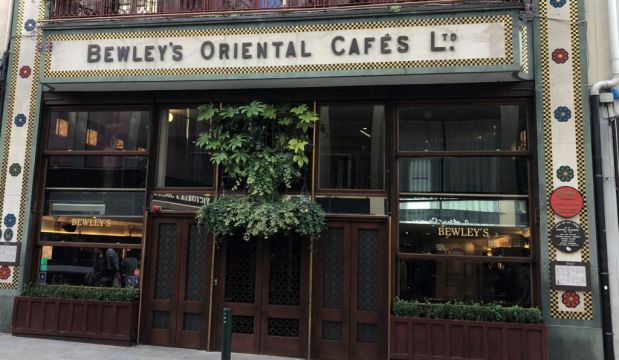A dispute about the repossession of Bewley's Café on Grafton Street, Dublin centres on whether six Harry Clarke stained-glass windows are part and parcel of the building or moveable artworks, the High Court has heard.
A company of developer Johnny Ronan, RGRE Grafton Ltd, is seeking possession of the building along with €747,000 in rent arrears against the tenant of the well-known premises, Bewley's Café Grafton Street (BCGS) Ltd, along with Bewley's Ltd.
The defendants have counterclaimed seeking a declaration the windows are moveable artworks which are not part of the structure of the premises. They are estimated to be worth €1 million.
Pandemic
The court heard the dispute arose after the café was badly hit by the pandemic lockdown and offered to offset the value of the windows in lieu of rent by selling them to RGRE. BCGS paid €1.4 million per annum rent under the lease.
RGRE rejected the offer saying BCGS could not sell to it what it already owned.
The case opened on Tuesday before Mr Justice Denis McDonald who heard the premises was first leased in 1928 by Ernest Bewley from Bewley's Oriental Café and over time the interests of the landlord merged.
Bernard Dunleavy SC, with Ross Aylward BL, for RGRE, said in 1987 the premises were sold to Royal Insurance which leased them back to BCGS in what was an "unusual transaction".
Ownership went from Royal Insurance to a number of parties over the years before ending up with RGRE.
It was RGRE's case that the windows were sold in 1987 to Royal Insurance because they were part and parcel of the windows and were part of the structure of the premises, counsel said.
Moveable chattels
The defendants claimed they are moveable chattels which are not part of the structure.
Mr Dunleavy said the defendants initially faced up to the difficulty presented by the indisputable fact that the windows were not retained as part of the sale contract before "retreating to the position" that the windows were not transferred in the sale because, they claimed, they were not windows at all.
Mr Dunleavy said it reminded him of the Christmas cracker joke of when is a window not a window: when it's ajar.
"In this case, it's 'when is a window not a window: when it's an objet d'art'", he said.
Mr Dunleavy said one of the features of this case was the use of the words "stained-glass windows" and "stained-glass panels".
RGRE's experts would say they were designed, supplied and fitted specifically as windows by the Harry Clarke studio in the late 1920s. They performed an illumination function for the rear of the premises and also a ventilation function. They were part of the sub-frame or sash of the windows, counsel said.
RGRE had evidence from original commissioning documents which say that they were a "set of windows" designed and fixed in place by the Harry Clarke studios in the late 1920s, counsel said.
Mr Dunleavy said the Harry Clarke windows are not the only stained-glass in Bewleys because, in the upstairs area, there are two stained-glass panels by the artist Pauline Bewick.

These two panels fit into picture frames and are suspended from the ceiling. "These are entirely decorative and not part of the property", counsel said.
If the court concludes that the Harry Clarke windows are part of the building, that is the end of the case for the defendant because RGRE cannot sell the building without its windows, he said.
If the conclusion is that they are not windows that is not the end of the case from RGRE's perspective because the court will have to then embark on consideration of the extent to which those decorative objects were permanently fixed in place, counsel said.
The case continues.







